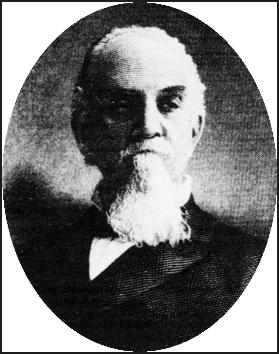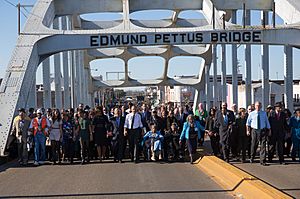Edmund Pettus Bridge facts for kids
Quick facts for kids Edmund Pettus Bridge |
|
|---|---|

The central span of the Edmund Pettus Bridge in April 2010
|
|
| Coordinates | 32°24′20″N 87°01′07″W / 32.40556°N 87.01861°W |
|
Edmund Pettus Bridge
|
|
| Location | Selma, Alabama, U.S. |
| Built | 1940 |
| Built by | T. A. Loving Company |
| NRHP reference No. | 13000281 |
| Significant dates | |
| Added to NRHP | February 27, 2013 |
| Designated NHL | February 27, 2013 |
| Carries | |
| Crosses | Alabama River |
| Characteristics | |
| Design | Through arch bridge |
| Total length | 1,248.1 feet (380.4 m) |
| Width | 42.3 feet (12.9 m) |
| Longest span | 250 feet (76 m) |
| Number of spans | 8 |
| Piers in water | 4 |
| Clearance above | 14.8 feet (4.5 m) |
| History | |
| Construction begin | 1939 |
| Construction end | 1940 |
| Opened | May 25, 1940 |
| Statistics | |
| Daily traffic | 17,720 |
The Edmund Pettus Bridge crosses the Alabama River in Selma, Alabama. It carries U.S. Route 80 Business. This bridge was built in 1940. It is named after Edmund Pettus, who was a general in the Confederate Army. He also served as a U.S. senator and was a leader of the Ku Klux Klan in Alabama.
The bridge is a through arch bridge made of steel. It has a main section that is 250 feet long. Nine large concrete arches help support the bridge on the east side.
The Edmund Pettus Bridge is famous for an event called Bloody Sunday. This happened on March 7, 1965. Police attacked Civil Rights Movement marchers there. The marchers were trying to walk to Montgomery, the state capital. They crossed the bridge again on March 21 and reached the Alabama State Capitol.
The bridge was named a National Historic Landmark in 2013. This means it is a very important place in American history.
Contents
What is the Edmund Pettus Bridge Like?
The bridge has four lanes for traffic. It carries U.S. Route 80 Business. This road used to be the main U.S. Route 80. The bridge goes over the Alabama River. It connects Selma on the west side to areas further east.
The bridge has 11 sections in total. Ten of these are smaller concrete sections. The main section over the river is made of steel. Selma is built on a high bank above the river. So, the west side of the bridge is higher than the east side. The middle of the bridge is 100 feet above the river. In 2011, experts said the bridge was "functionally obsolete." This means it's old and not designed for how much traffic uses it today.
Why is the Bridge Named Edmund Pettus?
The bridge is named after Edmund Pettus. He was a lawyer and a judge. He was also a general in the Confederate Army. Later, he became a U.S. senator. Pettus was also a state leader, or "Grand Dragon," of the Ku Klux Klan. This group supported slavery and racism.
Because of Pettus's past, some people want to change the bridge's name. This idea came up around the 50th anniversary of the Selma to Montgomery marches in 2015. To change the name, the Alabama Legislature would need to agree.
One suggested new name is John Lewis. He was a civil rights leader. He was also a congressman. John Lewis played a big part in the Selma to Montgomery marches. After he died in 2020, many more people wanted to rename the bridge for him. This happened after the killing of George Floyd led to many protests. These protests caused many controversial names to be changed across the country. However, John Lewis himself had said he did not want the bridge name to be changed before he died.
What is the History of the Edmund Pettus Bridge?
How Was the Bridge Built?
Before this bridge, an older bridge was built in 1885. It was one block east of the current bridge. That bridge was made of iron and had three sections. One section could swing open for boats to pass. A person had to operate it. Their small house is still there today.
The Edmund Pettus Bridge was designed by Henson Stephenson. He was from Selma. The bridge opened for cars in 1940.
The Bridge and Civil Rights

In 1965, voting rights for African Americans were a huge problem. In Selma, almost all registered voters were White. Only 1% were African American. But in 1960, 30% of Alabama's population was nonwhite.
In February 1965, a clash happened in Marion, Alabama. State troopers and local people confronted 400 unarmed African-American protesters. Jimmie Lee Jackson was shot and died eight days later. This event worried civil rights leaders. These included Martin Luther King Jr. and James Bevel. Bevel planned a peaceful march. It would go from Selma to the Alabama capitol in Montgomery. First, they had to cross the Pettus Bridge.
On March 7, 1965, armed police attacked the peaceful marchers. This event became known as Bloody Sunday. Because of how the bridge is shaped, the protesters could not see the police. They were on the other side of the bridge. The marchers first saw the police when they reached the middle of the bridge. This was 100 feet above the Alabama River. One protester, Hosea Williams, asked John Lewis if he could swim. Even with danger ahead, the protesters kept marching. Then, police and state troopers attacked them. They were beaten badly on the other side.
News channels showed pictures of the attack. Americans and people around the world saw the bloody and injured marchers. This made many people support the Voting Rights Movement. Amelia Boynton Robinson helped organize the march. She was beaten until she passed out. A photo of her on the bridge was on newspaper front pages everywhere. In total, 17 marchers went to the hospital. 50 more needed treatment for injuries. This day quickly became known as "Bloody Sunday."
What is the Bridge's Legacy?
Since 1965, many marches have honored Bloody Sunday. On its 30th anniversary, John Lewis returned. He was a leader during the Selma marches. He said it was good to see the changes. He saw more registered voters and more Black elected officials in Alabama.
On the 40th anniversary of Bloody Sunday, over 10,000 people marched. John Lewis was among them. They crossed the Edmund Pettus Bridge again.
The 1996 Summer Olympics torch relay also crossed the bridge. This was on its way to the Olympic Games in Atlanta. Andrew Young carried the Olympic flame. He helped organize Bloody Sunday. He later became a congressman and ambassador. Many officials joined him. This showed how much race relations had improved in the South. Young said, "We couldn't have gone to Atlanta with the Olympic Games if we hadn't come through Selma a long time ago."
In March 2015, on the 50th anniversary, U.S. President Barack Obama gave a speech. He was the first African-American U.S. president. He then led a march across the bridge. Other leaders joined him, like former President George W. Bush and Representative John Lewis. Civil Rights activists like Amelia Boynton Robinson were also there. About 40,000 people came to remember the 1965 march. They talked about its impact on history and ongoing efforts for civil rights.
After civil rights leader John Lewis died in July 2020, people again asked to rename the bridge for him. But Lewis had said he was against changing the name. He believed the name of the bridge was linked to the Voting Rights Movement. He felt it showed how that movement changed the nation. Part of Lewis's funeral procession crossed the bridge. His casket was carried in a special wagon. It was on its way to Montgomery.
Images for kids
See also
 In Spanish: Puente Edmund Pettus para niños
In Spanish: Puente Edmund Pettus para niños





